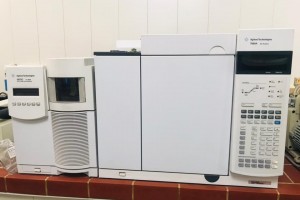
The College of Education for Pure Sciences in the Department of Life Sciences discussed a master's thesis on the synthesis of nanoparticles from some macroalgae and the study of their biological effectiveness. The thesis presented by the researcher (Zahraa Nouri Jaafar) included the current study on the use of the ethanolic extract of the algae Cladophora crispata and the algae Enteromorpha intestinalis, which are green algae, to determine their ability to manufacture silver nanoparticles and test their antibacterial effectiveness against different types of bacteria. The chemical active groups of the algae extract were extracted using the organic solvent ethanol, and qualitative chemical tests were conducted for them, which indicated the presence of alkaloids, flavonoids, glycosides, amino acids and carbohydrates. The chemical compounds were identified using Gas Chromatography – Mass Spectrometry (GC-MS) technology, which was represented by Hexadecanoic acid at a rate of 28.10% of the total percentage of the identified compounds, followed by Neophytadien at a rate of 12.07%, while Oleic acid formed a percentage of 11.72% for the C. crispata algae extract. As for the E. intestinalis algae extract, it contained the chemical compounds represented by n- Hexadecanoic acid, which formed a percentage of 37.40%, Octadecatrienoic acid, (Z,Z,Z)-9,12,15 at a percentage of 17.32%, Neophytadiene at a percentage of 12.07%, and Oleic acide formed a percentage of 11.08%. The ability of the algae extracts to manufacture silver nanoparticles AgNPs was tested as a preliminary test by changing the color of the mixture from light green to dark brown and by determining the wavelength using Ultra – Violet visible spectroscopy (UV-Vis) technology, as the absorption peak of C. crispata extract was determined at a wavelength of 417 nm and for E. intestinalis extract at a wavelength of 435 nm. Silver nanoparticles were characterized using different techniques represented by Fourier Transform Infrared spectroscopy (FTIR), which showed that the algae extract contained the active groups represented by carboxyl, carbonyl and hydroxyl, in addition to the presence of active amine groups. The shape and diameters of the nanoparticles were also determined using the Scanning Electron Microscope (SEM) technique, which showed spherical shapes for both extracts and diameters ranging between (47 - 78) nanometers for the nanoparticles manufactured by the C. crispata extract and with average diameters ranging between (29 - 99) nanometers for the nanoparticles manufactured by the E. intestinalis extract. The crystalline nature of the manufactured particles was also determined using the X-ray Diffraction (XRD) technique, and the Energy-Dispersive X-ray technique was used. X-ray spectroscopy (EDX) in determining the chemical elements that make up the manufactured particles, which were carbon, oxygen and chlorine.
The effectiveness of the algae extracts was tested against some types of Gram-negative bacteria, namely E. coli, Klebssiella pneumoniae and Pseudomonas aerugionosa, as well as one type of Gram-positive bacteria, namely Staphylococcus aureus, by adopting the Agar well diffusion method using different concentrations of the algae extracts.
The objectives of the thesis
Collect, characterize and purify two types of green algae isolated from the aquatic environment in Basra Governorate and demonstrate the ability of their extracts to manufacture nanoparticles.
Isolate and characterize the active compounds from the algae extracts using gas chromatography - mass spectrometry GC-mass.
And characterize silver nanoparticles using known diagnostic techniques.
The message recommended the use of other algal extracts as well as other organic solvents. Testing the toxicity of the extracts and manufactured nanoparticles on laboratory animals to confirm their toxicity and determine the lethal dose for them. Conducting many studies on the nanoparticles manufactured from algae for the purpose of adopting them as an effective alternative to antibiotics that have become resistant to some bacterial strains that are resistant to them alone.









